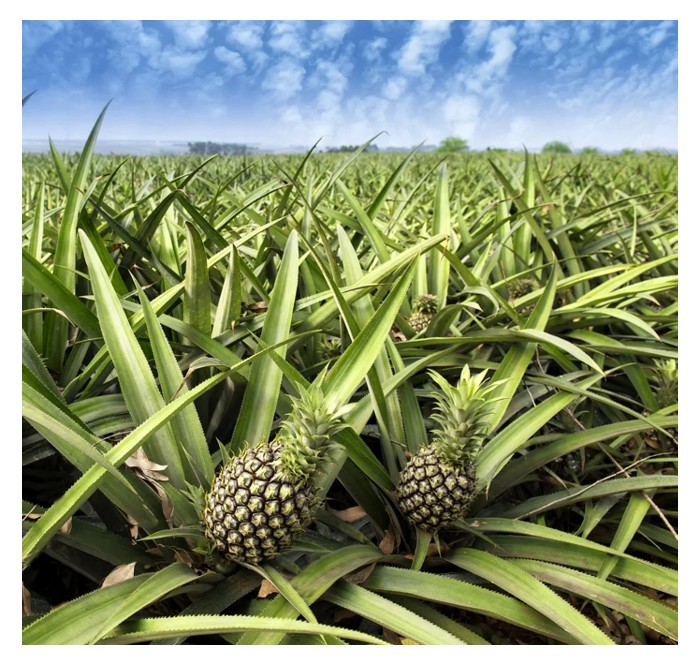When the first rays of morning light touch the rows of MD2 pineapples in the field, an experienced grower knows that sweetness doesn’t come from luck — it’s crafted. Every sugary bite of a golden MD2 pineapple tells a story of balance — between soil and water, nutrition and timing, sunlight and patience.
1. The Foundation: Sweetness Begins Underground
Long before the fruit forms, sweetness is decided in the soil. A farmer named Lim from Johor discovered that his sweetest MD2 batches came from well-drained loamy soils, slightly acidic (pH 4.5–5.5), rich in organic matter.
He began treating his soil not as dirt, but as a living system. Before planting, he incorporated composted chicken manure and biochar to boost microbial life. These microbes, in turn, helped release potassium — the mineral most responsible for sugar translocation within the pineapple plant.
“If you want sweet fruit,” Lim says, “you must first feed the soil, not the plant.”
2. The Sun Factor: Light Is the Natural Sweetener
MD2 pineapples love sunlight — at least 6–8 hours daily. Fields with shade from trees or buildings often produce pale, less sweet fruit. In Lim’s practice, he aligned rows in a north–south orientation, ensuring every plant receives balanced sunlight throughout the day.
He noticed something curious: fruits maturing during Malaysia’s drier months (April to July) tend to be sweeter. Excess rainfall dilutes sugars. Hence, in wetter regions, he adjusted the planting calendar — initiating flowering two months before the dry season to ensure the final ripening happens under strong sunlight and moderate stress.
3. Nutrition Strategy: Feeding for Flavour
Lim’s nutrient management became almost like a chef’s recipe. During the vegetative stage, he focused on nitrogen to build leaf canopy. But as the plants matured, he shifted towards high potassium (K) and moderate magnesium (Mg).
- Critical phase: 3–4 months before expected flowering
- NPK ratio: 1 : 2 : 4
- K sources: MOP (muriate of potash) or SOP (sulphate of potash, preferred for chloride-sensitive crops)
- Mg source: Kieserite or dolomite
This shift redirected the plant’s energy from leaf growth to sugar accumulation. He also used foliar sprays containing amino acids and trace boron, which improved sugar translocation within the fruit.
“Too much nitrogen after flowering,” he warns, “and your pineapple will grow big but taste like water.”
4. The Water Balance: Stress for Sweetness
Pineapple is a CAM plant, storing CO₂ at night and conserving water efficiently. Yet, controlled water stress just before fruit ripening enhances sugar concentration.
Lim learned to reduce irrigation gradually 2–3 weeks before harvest, allowing the plant to divert sugars from the leaves into the fruit. However, total water deprivation was avoided to prevent cracking or fruit burn. This “mild stress” mimics natural dry-season ripening, concentrating both aroma and sweetness.
5. Flower Induction Timing: Precision Matters
Flower induction is not just about forcing blooms — it’s about timing for quality. When Lim induced flowering too early (less than 8 months after planting), the fruit was smaller and less sweet. Too late, and it became fibrous.
He found the sweet spot at 9–10 months, when the plant had at least 40–45 functional leaves. This ensured that the plant’s carbohydrate reserves were high, directly influencing final sugar content (Brix).
He also used ethephon (50–60 ml/200 L water) mixed with urea and calcium carbide for even induction, always ensuring uniform application during cool morning hours.
6. Maturity Management: Patience for Peak Brix
Once the fruits start turning golden, the temptation to harvest early is strong — especially for export schedules. But Lim adopted the “7-day rule”:
- He waited 7 additional days after the fruit turned 50% yellow on the shell before harvest. This allowed maximum sugar accumulation, reaching Brix values of 18–20°, compared to 14–15° in early-harvested fruit.
- He also noticed that pineapples harvested early and ripened artificially never matched the sweetness of naturally matured fruit — not even close.
7. Postharvest Sweetness: The Last 10%
Surprisingly, handling after harvest can still affect perceived sweetness. Fruits exposed to direct sun or rough handling lose moisture and aroma. Lim’s crew always harvested during early morning, placed fruits under shade, and cooled them before transport.
He stored ripe pineapples at 10–12°C to retain sugar-acid balance — crucial for maintaining the signature MD2 sweetness and aroma during export.
Conclusion: Sweetness as an Art and Science
Enhancing MD2 pineapple sweetness is more than applying fertilizers or irrigation — it’s a dialogue between grower and plant. Lim’s approach combines biological soil health, precise nutrition, strategic water stress, and patient harvest timing.
Every field, every season, tells a slightly different story. But one truth remains:
“The sweetest pineapples are grown by farmers who pay attention — not just to their plants, but to the rhythm of nature.”
Source: Professional Platform
Note: For Reference Only










